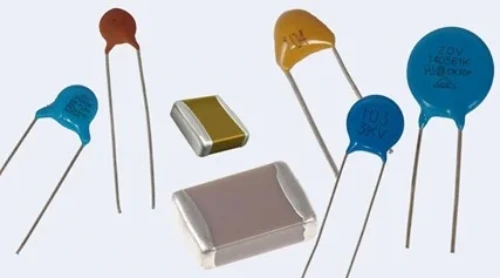To expand your news reach, consider advertising with our media partner, Patch Media, at https://heypapipromotionsmedia.town.news/. Patch is a nationwide news network comprising over 1,000 hyperlocal websites dedicated to community news across the United States. For press release distribution services, please call or visit https://heypapipromotions.com/advertise.
A ceramic capacitor uses ceramic material as its dielectric. Ceramics were among the first materials used for capacitor production due to their insulating properties. Various geometries have been employed in ceramic capacitors over the years, but some, like ceramic tubular capacitors and barrier layer capacitors, have become obsolete due to issues related to size, parasitic effects, or electrical characteristics.
The most commonly used ceramic capacitors in modern electronics are the multi-layer ceramic capacitor (MLCC) and the ceramic disc capacitor. MLCCs, in particular, are the most widely produced capacitors, with approximately 1000 billion units manufactured annually. They are made using SMD (surface-mounted) technology, which allows for a compact size.
Typically, ceramic capacitors have very small capacitance values, ranging from 1nF to 1µF, although they can go up to 100µF. They are also very small in size and have a low maximum rated voltage. Importantly, ceramic capacitors are not polarized, meaning they can be safely connected to an AC source. They also offer excellent frequency response due to minimal parasitic effects such as resistance or inductance.
Characteristics of Ceramic Capacitors
Precision and Tolerances
Ceramic capacitors are classified into two main categories: Class 1 and Class 2. Class 1 ceramic capacitors are chosen for applications requiring high stability and minimal losses. They exhibit high accuracy, maintaining stable capacitance values despite variations in applied voltage, temperature, and frequency. For instance, capacitors in the NP0 series boast a thermal stability with a variation of ±0.54% across a temperature range from -55 to +125 °C. Tolerances for the nominal capacitance value can be as low as 1%.
On the other hand, Class 2 capacitors offer higher capacitance per unit volume and are suitable for less critical applications. They typically have a thermal stability of ±15% within their operational temperature range, with nominal value tolerances around 20%.
Size Advantages
Multi-layer ceramic capacitors (MLCCs) provide significant advantages in high-density component packing, crucial for modern printed circuit boards (PCBs). For example, an "0402" MLCC package measures just 0.4 mm x 0.2 mm, containing 500 or more ceramic and metal layers. As of 2010, the minimum ceramic thickness in such packages is approximately 0.5 microns.
High Voltage and High Power
Ceramic capacitors designed for high voltage and high power applications are physically larger and known as power ceramic capacitors. These capacitors feature specialized terminals for safe connection to high voltage supplies. They can withstand voltages ranging from 2kV up to 100kV, with power ratings exceeding 200 volt-amperes.
In contrast, smaller MLCCs used in PCBs are typically rated for voltages ranging from a few volts up to several hundred volts, depending on the specific application requirements.
Construction and Properties of Ceramic Capacitors
Ceramic Disc Capacitors
Ceramic disc capacitors are produced by coating a ceramic disc with silver contacts on both sides. These capacitors can achieve larger capacitances by utilizing multiple layers. Traditionally used as through-hole components, ceramic disc capacitors are becoming less popular due to their size. In modern applications, Multi-Layer Ceramic Capacitors (MLCCs) are preferred whenever capacitance values permit.
Ceramic disc capacitors typically offer capacitance values ranging from 10pF to 100μF, covering a wide spectrum of voltage ratings from 16 volts to 15 kV and beyond. Despite their declining popularity, they remain versatile components suitable for various voltage and capacitance requirements in electronic circuits.
Multi Layer Ceramic Capacitor (MLCC)
MLCCs are manufactured using a precise process that involves mixing finely ground granules of paraelectric and ferroelectric materials. These materials are layered alternately with metal contacts. Once the layering is complete, the device undergoes high-temperature sintering, which transforms the mix into a ceramic material with desired properties. The resulting capacitor essentially comprises numerous smaller capacitors connected in parallel, thereby increasing the overall capacitance.
Modern MLCCs typically consist of 500 layers or more, with the minimum layer thickness approximately 0.5 microns. As technological advancements progress, the layer thickness continues to decrease, enabling higher capacitances within the same volume. This evolution in manufacturing allows MLCCs to offer improved performance characteristics and greater capacitance densities for various electronic applications.
Applications for Ceramic Capacitors
Considering that MLCCs are the most widely manufactured capacitors in the electronics industry, their applications span a wide range. One notable application is in high-precision, high-power circuits, such as resonant circuits in transmitter stations. Class 2 capacitors are employed in high-power applications like high voltage laser power supplies, power circuit breakers, and induction furnaces.
Small-form SMD (surface mount) capacitors find extensive use in printed circuit boards (PCBs), where space efficiency is crucial. These capacitors can be as small as a grain of sand, enabling high-density PCB designs. They are also integral to DC-DC converters, which subject components to high frequencies and electrical noise.
Ceramic capacitors, being non-polarized and available in a diverse range of capacitances, voltage ratings, and sizes, serve as general-purpose capacitors in various electronic circuits. Many hobbyists, particularly those in robotics, are familiar with ceramic disc capacitors used alongside brush DC motors to reduce RF noise.
In summary, the versatility and reliability of ceramic capacitors, especially MLCCs, make them indispensable across numerous electronic applications, ranging from high-power industrial equipment to compact consumer electronics and hobbyist projects.
